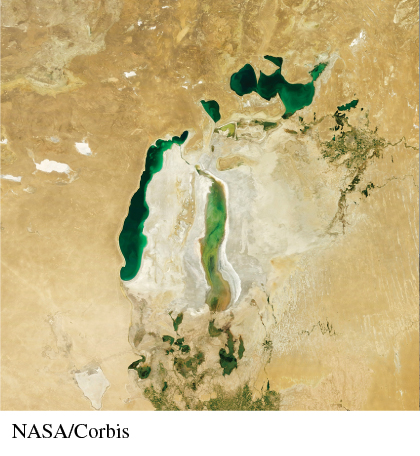Introduction to Chapter 8
125
Instructor's Notes
To download handouts of the Learning by Doing activities and checklists that appear in this unit, and to access lecture slides, teaching tips, and Instructor’s Manual materials, go to the “Instructor Resources” folder at the end of this unit.
8
Explaining Causes and Effects


Responding to an Image
Since the 1960s, the size of the Aral Sea in Uzbekistan has greatly decreased, as shown in the inset 2009 satellite image. The decreased area is due largely to short-sighted irrigation projects that diverted the rivers that fed this body of water. The resulting environmental disaster left formerly prosperous fishing villages marooned many miles from any shoreline and brought pollution, hardship, and a more extreme climate to the area. These two images suggest both causes and effects. What causes can you identify? What effects? Also consider artistic choice—the selection of each scene and the vantage point from which it was photographed. What mood does each photograph create? How does each affect you?
126
When a house burns down, an insurance company assigns a claims adjuster to look into the disaster and ask, Why? He or she investigates to find the answer—the cause of the fire, whether lightning, a cooking mishap, or a match that someone deliberately struck—and presents it in a written report. The adjuster also details the effects of the fire—what was destroyed or damaged, what replacement or restoration will be necessary, what repairs will be required, how much they will cost, and how long the family may need temporary housing.
Often in college you are asked to investigate and think like the insurance adjuster, tracing causes or identifying effects. To do so, you have to gather information to marshal evidence. Effects are usually easier to identify than causes. Results of a fire are apparent to an onlooker the next day, although its cause may be obscure. For this reason, seeking causes and effects may be an uncertain pursuit, and you are unlikely to set forth definitive explanations with absolute certainty.
Why Explaining Causes and Effects Matters
In a College Course
You explore causes or effects to add depth to your papers whether you are investigating teen parenthood in sociology, romanticism in American fiction, or head traumas in speech pathology.
You identify causes (such as those for the decline or the revival of the U.S. auto industry) or effects (such as those of widespread unemployment in Detroit) in essay exams.
In the Workplace
You consider causes and effects when you recommend changing from one advertising campaign to another to improve sales or from an old procedure to a new one to improve quality, efficiency, or safety.
In Your Community
You use causal analysis to help you advocate for more rigorous standards for the fuel efficiency of new vehicles or for stronger school board support for early childhood programs.
 When have you explained causes, effects, or both in your writing? What situations are likely to require this kind of analysis?
When have you explained causes, effects, or both in your writing? What situations are likely to require this kind of analysis?